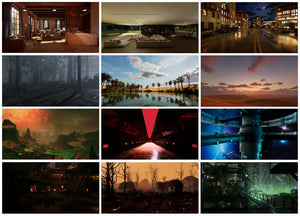Immersive Learning Environments Design Guide for Virtual Production

The evolution of education has reached an unprecedented turning point where traditional classrooms transform into dynamic, interactive spaces that respond to student needs in real-time. Immersive learning environments represent the future of education, combining cutting-edge technology with pedagogical excellence to create spaces where learning becomes an active, engaging process rather than passive information consumption.
Virtual production technologies now enable educators to design learning spaces that were previously impossible to imagine. Students can walk through ancient Rome, manipulate molecular structures with their hands, or collaborate on complex engineering projects within simulated environments that feel completely real. This transformation requires careful planning, strategic implementation, and deep understanding of how technology serves educational goals.
Modern educational environment design goes beyond simply adding screens to classrooms. It involves creating cohesive ecosystems where physical and digital elements work together seamlessly, supporting different learning styles while maintaining the human connections that make education meaningful.
Understanding Modern Educational Space Requirements
Creating effective learning space technology requires analyzing how students learn best and what environments support optimal educational outcomes. Research consistently shows that students retain information better when they can interact with content actively rather than consuming it passively.
The traditional lecture hall model, where students sit in rows facing a single presentation screen, limits engagement and fails to accommodate diverse learning preferences. Modern immersive spaces must support visual learners who need to see concepts in action, kinesthetic learners who learn through movement and manipulation, and auditory learners who process information through sound and discussion.
Successful educational spaces now integrate multiple sensory inputs while maintaining flexibility to adapt to different subjects and teaching methods. A single room might transform from a historical simulation space in the morning to a scientific laboratory in the afternoon, then become a collaborative workspace for group projects in the evening.
Key Components of Immersive Educational Design
Spatial Flexibility and Modular Systems
Effective classroom immersion begins with spaces that can adapt to different educational needs. Modular furniture systems allow rapid reconfiguration from individual workstations to collaborative groups or presentation formats. Technology infrastructure must support these changes without requiring complex setup procedures that interrupt learning flow.
Wall-mounted displays, ceiling-integrated projection systems, and wireless connectivity ensure that technology remains accessible regardless of room configuration. Students should be able to share content instantly from personal devices while teachers maintain control over the primary learning environment.
Multi-Sensory Integration Technologies
Modern learning environments integrate visual, auditory, and tactile feedback systems that reinforce educational content through multiple channels. High-resolution displays provide crystal-clear visual content, while spatial audio systems create three-dimensional soundscapes that help students understand complex concepts through sound positioning and movement.
Haptic feedback systems allow students to feel textures, resistance, and spatial relationships within virtual environments. Medical students can feel the resistance of different tissues during virtual surgeries, while engineering students experience the physical properties of materials they're designing with.
Collaborative Technology Platforms
Educational experience design must support both individual learning and group collaboration. Interactive surfaces enable multiple students to work simultaneously on shared projects, while personal devices maintain individual workspaces that can contribute to group efforts.
Real-time content sharing allows students to contribute ideas, share resources, and build upon each other's work without technical barriers. Teachers can monitor all activities simultaneously, providing guidance and feedback as needed without interrupting the collaborative flow.

Leading Companies Transforming Educational Spaces
ARWALL - Pioneer in Educational Immersion
ARWALL leads the industry in creating comprehensive immersive learning solutions that transform traditional educational spaces into dynamic, interactive environments. Their technology platforms integrate seamlessly with existing educational infrastructure while providing unprecedented levels of immersion and interactivity.
ARWALL's systems support real-time content creation, allowing educators to modify lessons dynamically based on student responses and engagement levels. Their solutions scale from individual classrooms to campus-wide implementations, maintaining consistency while accommodating diverse educational needs.
Immersive Display Solutions
Companies specializing in educational display technology create large-format interactive surfaces that respond to touch, gesture, and voice commands. These systems replace traditional whiteboards with dynamic surfaces that can display any content while maintaining the tactile interaction that educators value.
Advanced projection mapping technologies transform entire classroom walls into interactive surfaces, creating truly immersive environments where students feel surrounded by educational content rather than simply viewing it from a distance.
Virtual Reality Educational Platforms
Specialized VR companies focus specifically on educational applications, creating content libraries and delivery systems designed for classroom use. These platforms provide age-appropriate content that aligns with curriculum standards while maintaining the engagement that makes VR technology so effective for learning.
Augmented Reality Learning Systems
AR technology companies create solutions that overlay digital information onto physical objects and spaces, allowing students to see additional layers of information about real-world items. Students can point tablets at historical artifacts to see them in their original context or examine engineering components to understand their internal structures.
Implementation Strategies for Educational Institutions
Phased Deployment Approaches
Successful immersive learning implementation typically follows a phased approach that allows institutions to test technologies, train staff, and refine processes before full-scale deployment. Starting with pilot programs in selected classrooms provides valuable insights while minimizing risk and investment.
Initial phases focus on core technologies that provide immediate value, such as interactive learning spaces with collaborative displays and wireless content sharing. Subsequent phases add more sophisticated immersion technologies as staff become comfortable with basic systems and students adapt to new learning methods.
Staff Training and Support Systems
Technology adoption succeeds only when educators feel confident using new tools effectively. Comprehensive training programs must address both technical operation and pedagogical integration, helping teachers understand how immersive technologies enhance rather than replace effective teaching methods.
Ongoing support systems ensure that technical issues don't interrupt learning. On-site technical staff, remote support capabilities, and user-friendly interfaces minimize disruption while maximizing educational impact.
Content Development and Curriculum Integration
Immersive technologies require educational content designed specifically for interactive, three-dimensional environments. Traditional textbook content doesn't translate directly to immersive formats, requiring new approaches to content creation and curriculum development.
Partnerships with content creators, subject matter experts, and technology providers help institutions develop comprehensive libraries of immersive educational materials that align with learning objectives while taking full advantage of technological capabilities.

Measuring Success in Immersive Learning Environments
Student Engagement Metrics
Effective measurement systems track multiple indicators of student engagement, including participation rates, time-on-task, and voluntary exploration of additional content. Immersive environments generate detailed analytics about student interactions, providing insights into learning patterns that were previously invisible.
Attention tracking, interaction frequency, and collaboration patterns help educators understand which elements of immersive lessons work most effectively and which need adjustment. This data-driven approach enables continuous improvement of both technology implementation and educational content.
Learning Outcome Assessment
Traditional testing methods may not fully capture the benefits of immersive learning experiences. New assessment approaches evaluate students' ability to apply knowledge in simulated real-world contexts, demonstrating practical understanding rather than memorization.
Portfolio-based assessments showcase student projects created within immersive environments, providing evidence of creative problem-solving and collaborative skills that traditional tests cannot measure effectively.
Long-term Educational Impact
Longitudinal studies track how immersive learning experiences affect student retention, graduation rates, and career preparation. Students who learn through immersive technologies often report higher satisfaction with their educational experience and better preparation for professional environments that increasingly rely on similar technologies.
Future Trends in Educational Environment Design
Artificial Intelligence Integration
AI systems will increasingly personalize immersive learning experiences, adapting content difficulty, pacing, and presentation style to individual student needs. These systems will recognize when students struggle with concepts and automatically provide additional support or alternative explanations.
Intelligent tutoring systems within immersive environments will offer 24/7 support, helping students work through problems and providing guidance when human instructors aren't available.
Biometric Feedback Systems
Future learning environments will incorporate biometric monitoring to understand student stress levels, attention, and emotional responses to different educational content. This information will help optimize learning conditions and identify when students need breaks or additional support.
Global Collaborative Classrooms
Immersive technologies will enable students from different geographic locations to collaborate in shared virtual spaces, creating global classrooms that transcend physical boundaries. Students will work together on projects, share cultural perspectives, and learn from diverse viewpoints without leaving their local institutions.
Conclusion
Immersive learning environments represent a fundamental shift in how education is delivered and experienced. By thoughtfully integrating technology with sound pedagogical principles, educational institutions can create spaces that engage students more effectively, support diverse learning styles, and prepare learners for an increasingly digital future.
Success in implementing these environments requires careful planning, adequate training, and ongoing support. Institutions that take a strategic approach to immersive technology adoption will find themselves at the forefront of educational innovation, providing students with learning experiences that are both more engaging and more effective than traditional methods.
The investment in immersive learning technologies pays dividends through improved student outcomes, higher engagement levels, and better preparation for professional environments. As these technologies continue to evolve, early adopters will have significant advantages in attracting students and delivering superior educational experiences.

Frequently Asked Questions
Q: What makes an immersive learning environment different from a traditional classroom?
A: Immersive learning environments use advanced technology to create interactive, three-dimensional educational experiences where students can manipulate objects, walk through historical settings, or collaborate in virtual spaces. Unlike traditional classrooms with static displays, these environments respond to student actions and adapt content in real-time.
Q: How much does it cost to implement immersive learning technology?
A: Implementation costs vary significantly based on room size, technology complexity, and features required. Basic interactive displays and wireless collaboration tools might cost $10,000-$30,000 per classroom, while full immersive environments with VR/AR capabilities can range from $50,000-$200,000. Many institutions use phased implementation to spread costs over time.
Q: What training do teachers need to use immersive learning systems effectively?
A: Teachers typically need 20-40 hours of initial training covering technical operation, content creation, and pedagogical integration. Ongoing support includes regular workshops, peer mentoring, and technical assistance. Most successful programs provide both formal training sessions and hands-on practice time with gradual introduction of advanced features.
Q: How do you measure the effectiveness of immersive learning environments?
A: Effectiveness measurement combines traditional academic metrics with new indicators like engagement time, interaction frequency, and collaborative participation rates. Many institutions track knowledge retention, practical application skills, and student satisfaction alongside standard test scores to get a complete picture of educational impact.
Q: What subjects benefit most from immersive learning environments?
A: STEM subjects, history, geography, and languages show particularly strong benefits from immersive learning. However, virtually any subject can benefit when content is designed appropriately. Medical education, engineering, architecture, and social sciences have seen dramatic improvements in student understanding and retention through immersive technologies.
Q: How do immersive learning environments accommodate different learning styles?
A: These environments naturally support multiple learning styles by providing visual, auditory, and kinesthetic input simultaneously. Visual learners benefit from high-resolution displays and 3D modeling, auditory learners engage with spatial sound design, and kinesthetic learners interact through touch, gesture, and movement within the space.
Q: What technical support is required for immersive learning systems?
A: Most systems require on-site technical staff or reliable remote support contracts. Daily operation should be simple enough for teachers to manage independently, but more complex troubleshooting, software updates, and hardware maintenance need specialized technical expertise. Many institutions partner with technology vendors for ongoing support services.
Q: Can immersive learning environments work in existing classroom spaces?
A: Yes, many immersive technologies can be retrofitted into existing classrooms. Portable systems, wall-mounted displays, and wireless technologies minimize infrastructure requirements. However, purpose-built spaces with proper lighting control, acoustics, and power distribution will always provide better results than retrofit installations.




